NORTH WALES COAST RAILWAY:NOTICE BOARD
Rheilffordd arfordir gogledd Cymru: Hysbysfwrdd
29 August 2022




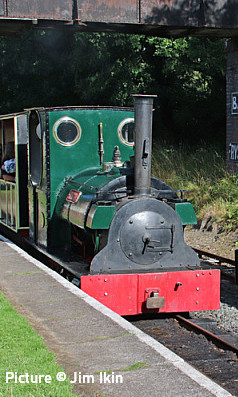
Contributions to the Notice Board are welcome, although they may not always be used, due to time constraints, especially if they don't follow the file name convention given on the Contributions Page.
Forthcoming events
Charter trains, and meetings, may be subject to cancellation or postponement. See our Calendar Page for Club and Society details.
September 2022
Friday 2 September Clwyd Railway Circle: The Greatest Railway Builder in the World A 60 Minute Talk on the Life and Times of Thomas Brassey by Peter Bolt
3-4 September Llangollen Railway Diesel Weekend
Saturday 3 September The Cheshireman steam (6233) Norwich - Chester and return (diesel Peterborough - Norwich)
Friday 9 September Pathfinder Tours Cambrian Coast Express. Oxford - Pwllheli
24 September Trailffest Half Marathon : An Event Train will be provided to take the competitors from the event centre at Porthmadog to the start of the race in Tanygrisiau, the cost of which is included in the entry fee.
Friday 7 October Fond Memories A look back over 70 years of Railway interest by Larry Davies
7-9 October: Ffestiniog and Welsh Highland Railways: Vintage weekend.
8-9 October Llangollen Railway DMU railcar weekend
November 2022
Friday 4 November Clwyd Railway Circle: A trip by Norwegian Railways to Hell (and back). Geoff Morris
Saturday 5 November Llangollen Railway Ride the Rocket Firework Train
December 2022
Friday 2 December Clwyd Railway Circle: Members Selections & Christmas Celebrations Members are invited to give a 15-minute presentation of their choice (Any format). Contact David Jones 01244 537440 to book a slot.
(see our Calendar page for meeting venues)
North Wales Coast Railway website created and compiled by Charlie Hulme
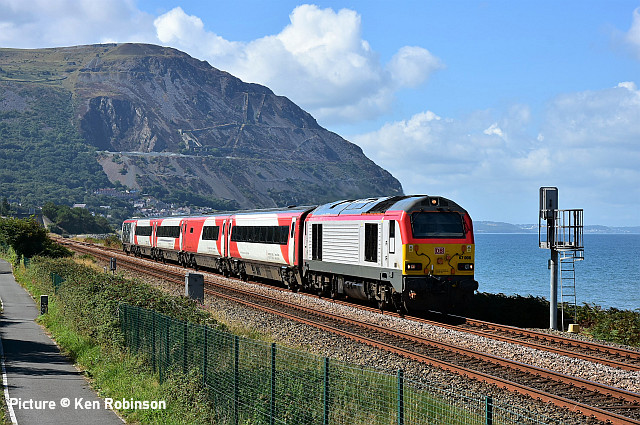
67 008 passes Dwygyfylchi with train 1V96, the 11:33 Holyhead-Cardiff, 25 August. Picture by Ken Robinson.
Timetable news
The timetables from December 22 onwards have now been released and can be viewed on Real Time Trains and other such services by choosing a date beyond the change. The stand-out change is that some locomotive-worked trains on the Manchester - South Wales axis are included; these will be worked by Class 67 locos and the ex-LNER coaching stock which TfW obtained following the abandonment of Grand Central's London - Blackpool plan.
On the Borderlands line, it appears that it appears that the Class 230 'D-trains' will work the hourly service; time will tell.
Making Tracks
If you haven't already visited the large model railway exhibit at Chester Cathedral created by Peter Waterman and his team, based on a section of the West Coast Main Line, there is still time - the last day of operation is Saturday 3 September. Full information on the Cathedral website.
Stone for Yorkshire
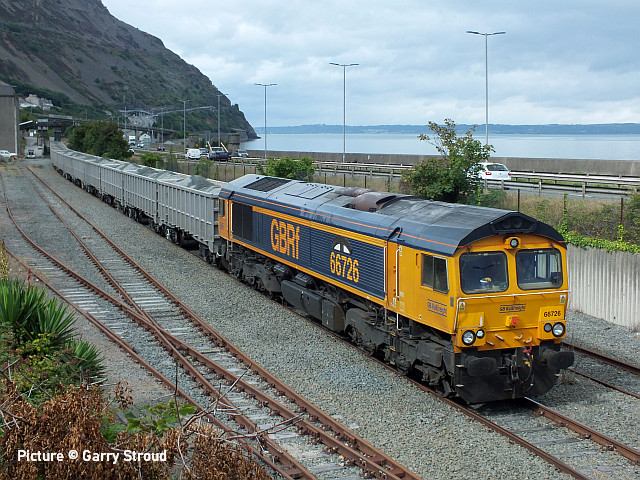
66 726 Sheffield Wednesday worked the Penmaenmawr - Tuebrook sidings stone train on 23 August, photographed at the quarry by Garry Stroud ...
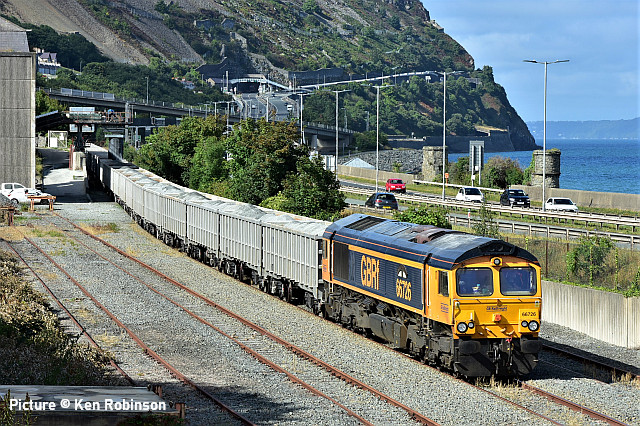
... and two days later on 25 August the 'footballer' was back: this time the train broke new ground by running to a terminal in Hunslet, Leeds rather than Tuebrook Sidings. The fine weather allowed some fine images of the train. Above, captured during loading at Penmaenmawr ...
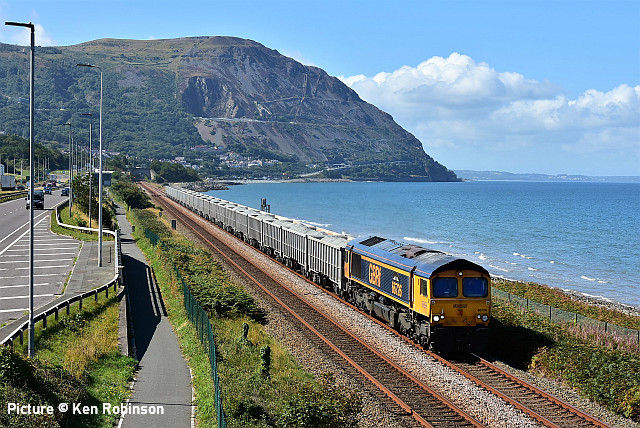
... and passing Dwygyfylchi with the loaded train (Ken Robinson).
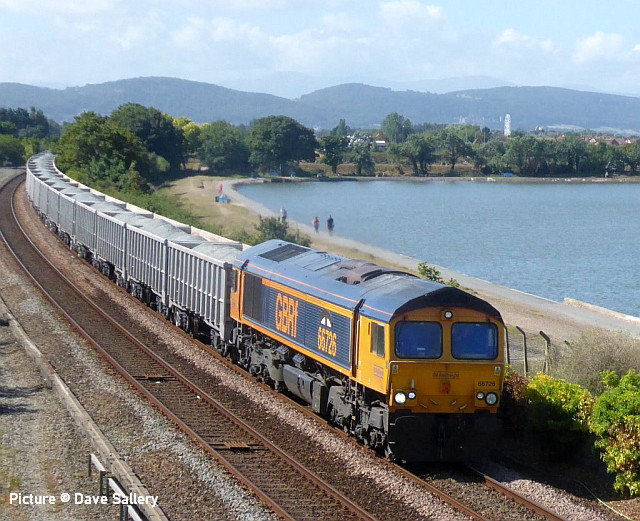
Passing Rhyl Marine Lake (Dave Sallery). The route is via Crewe Basford Hall, Stockport, Healey Mills, Wakefield and Leeds.
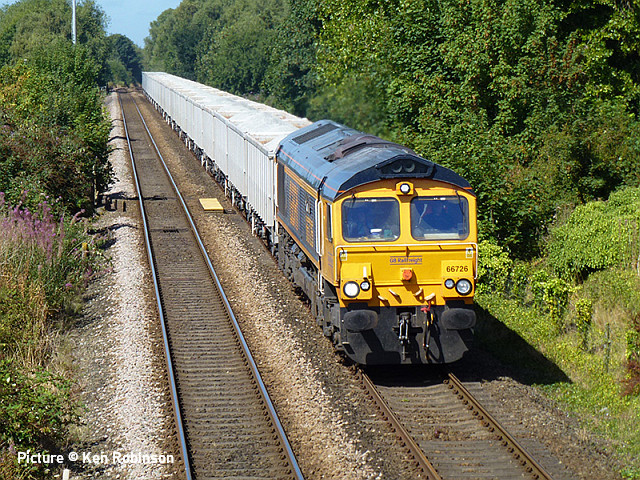
Flint (Stephen Dennett). Let's hope the 'street artists' are kept away from this train: the Freightliner stone trains in the Peak District are a truly sad sight.
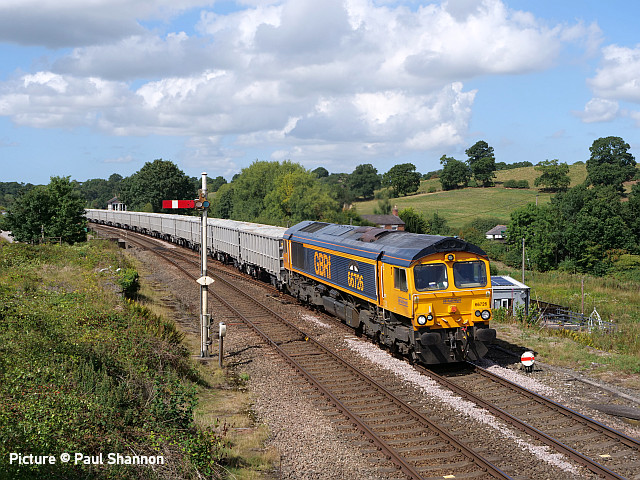
Near Beeston Castle: picture by Paul Shannon, who notes: 'This working offered the unusual sight of a freight train on the Chester - Crewe line. The two trial slate waste trains from Llandudno Junction to Luton also came this way but all previous Penmaenmawr trains have gone to Tuebrook sidings via Warrington'.
News from the Log train
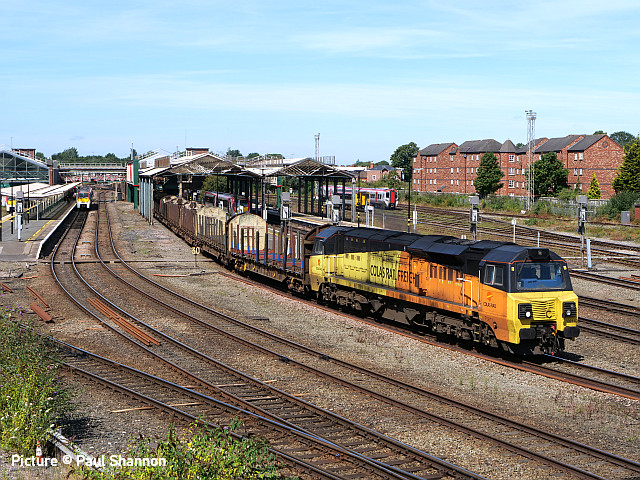
On 19 August, 70 811 with the Sunday Chirk - Carlisle empty timber wagons was unusually diverted via Chester, as seen above (Paul Shannon).
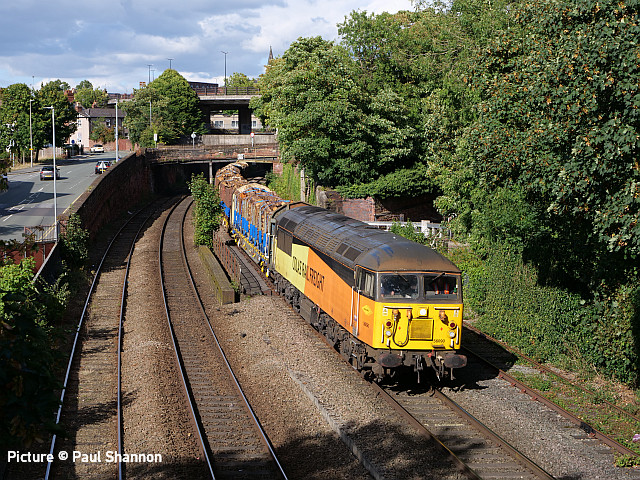
On the same day, 56 090 hauled the first Hellifield - Chirk timber train. The regular Carlisle working was following about two hours behind it and was held at Chester to make sure that the Hellifield train had vacated the Kronospan siding by the time it arrived (Paul Shannon).
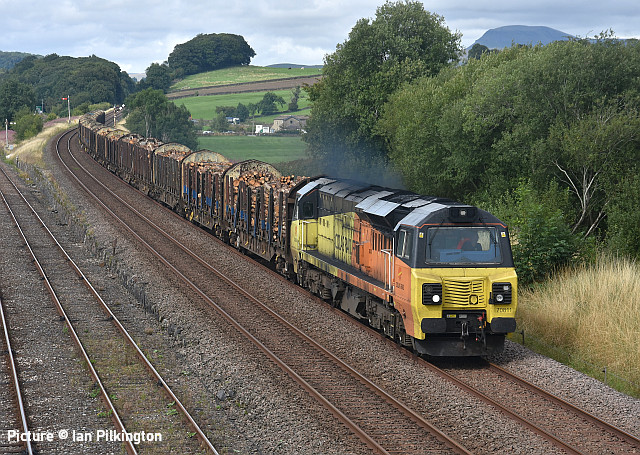
70 811 again, approaching Settle Junction with 6J37 Carlisle-Chirk logs on 24 August (Ian Pilkington).
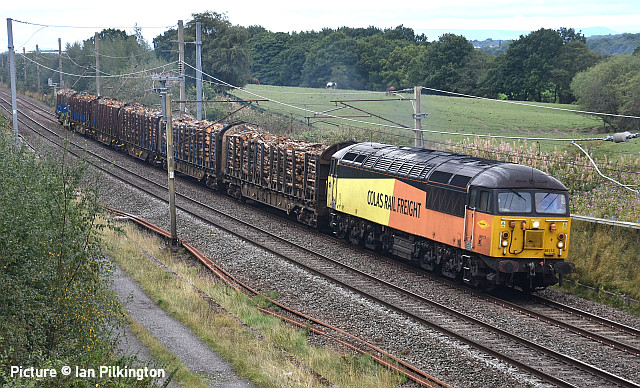
56 113 passes Charnock Richard on the West Coast Main line with 6Z34 Hellifield - Chirk logs on Monday 29 August, the second run of a this trial working (see above). Picture by Ian Pilkington who notes: 'The West Coast Railway Company's sidings at Hellifield are being used for loading instead of the stone sidings at Ribblehead which were used when a regular weekly flow ran a few years ago. Curiously on both the 19th and 29th the Hellifield train has run only a few hours ahead of the usual train from Carlisle.'
Lunchtime at Flint, 25 August - with Stephen Dennett
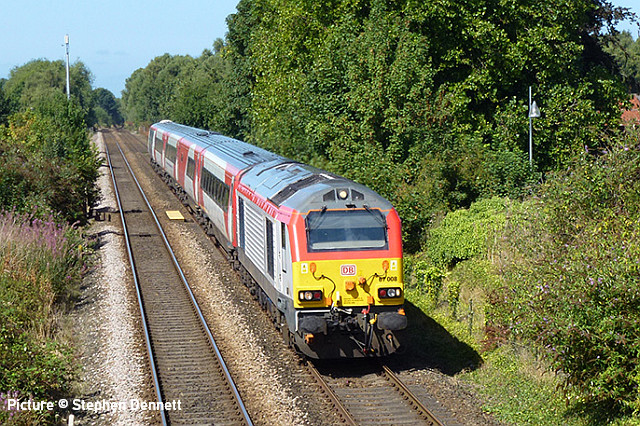
67 008 arrives at Flint with the 11:33 Holyhead - Cardiff Central loco-hauled service.
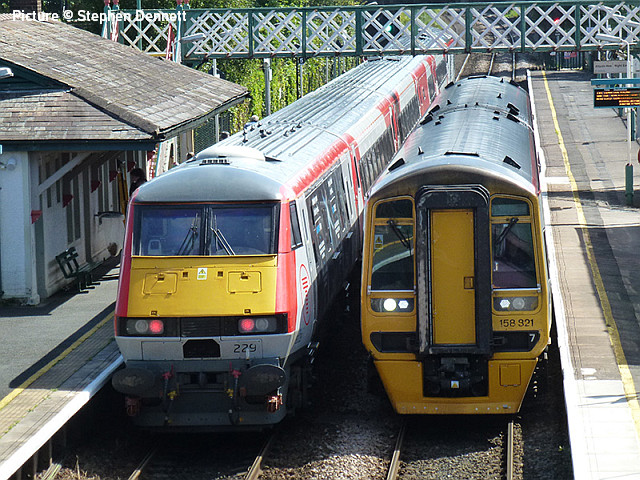
158 821 arrives at Flint with the 09:22 Cardiff Central to Holyhead service. DVT 82229 is on the rear of the Holyhead to Cardiff Central loco-hauled train.
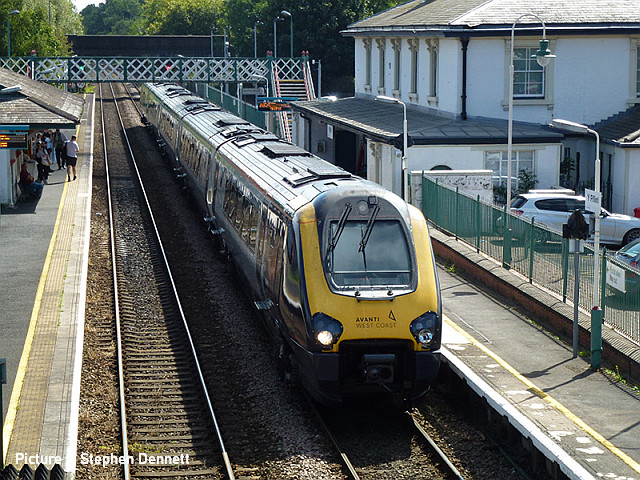
Voyager 221 113 calls at Flint with a Crewe to Holyhead service.
More about the Shotton 50th - By Barrie Hughes
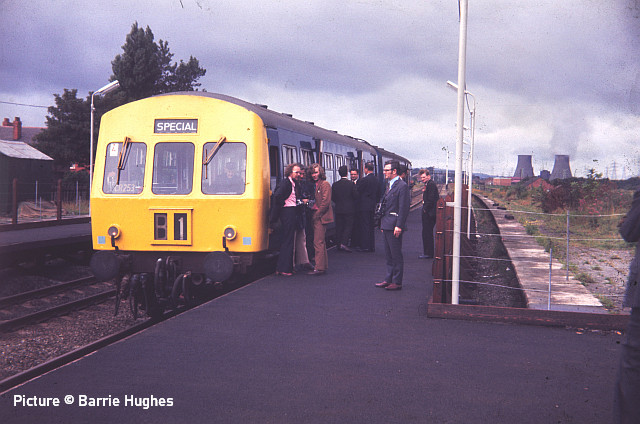
Following the piece about the 50th anniversary of Shotton Low Level, here are some images from the actual re-opening ceremony on 17 August 1972, with BR managers and Flintshire council officials.
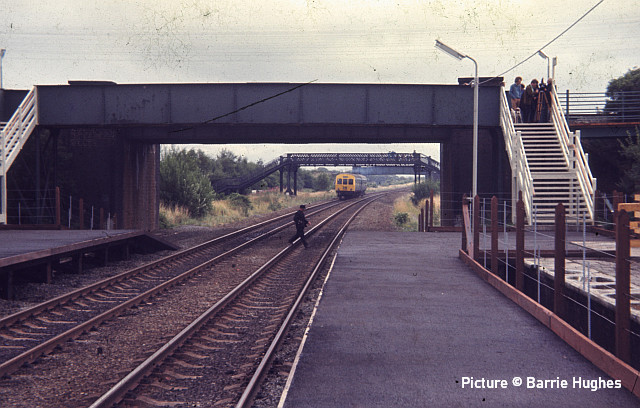
After the event: note the film crew at top of the steps and the staff member crossing the tracks There was no barrow crossing as BR had decided to do away with these and eventually the end ramps that were associated with them!
Avanti service cuts
The Crewe to Holyhead shuttle is part of Avanti's drastic timetable cuts which have resulted in basically four departures per hour from London Euston: one to each of Glasgow, Liverpool, Manchester and Birmingham. Every two hours, the Birmingham train continues to Edinburgh, via the West Midlands, others serve Blackpool. Chester and North Wales passengers have to change at Crewe. The 18:10 from Wrexham also (apparently) operates.
Un-surprisingly this has created a political 'furore', especially in Manchester where three trains per hour are replaced by one. The problem appears to be that there are not enough drivers to work the normal service, due to retirements and covid-related training delays, compounded by the decision of staff not to work on their 'rest days.' Talk of 'strike action' by Avanti managers is not helping the situation.
Crewe-based Locomotive Services have decided to exploit the situation by running a Friday charter train from Crewe to Euston, returning in the evening from Euston to Manchester, using their 'Inter-City' rake of Mk3 Coaches, with a single fare of £75. The first two trains don't appear to have attracted much patronage.
From Dave Sallery's archive
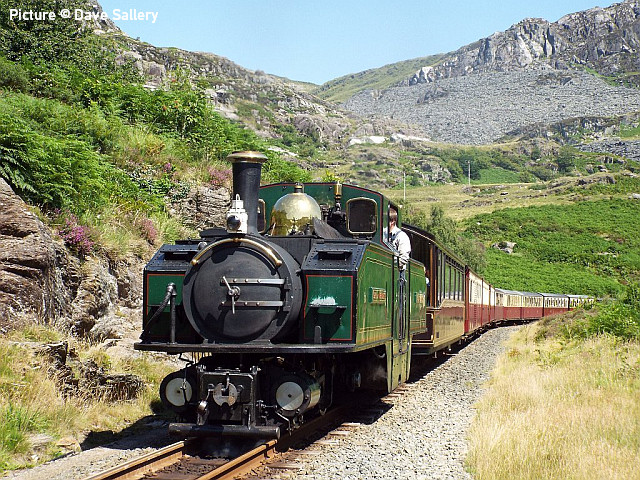
The Ffestiniog Railway's now withdrawn Earl of Merioneth near Tan y Grisiau in 2017.
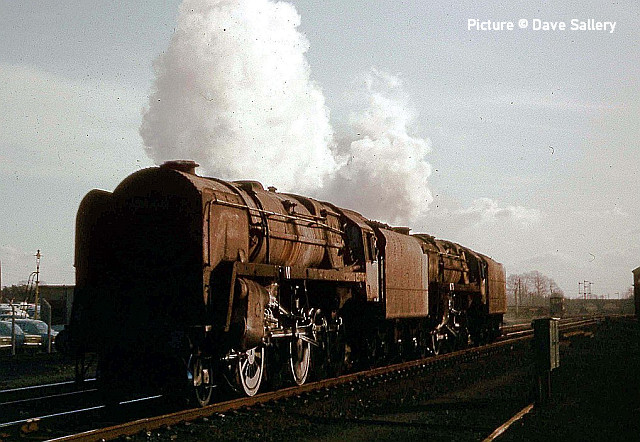
A pair of 9F 2-10-0's pass Hooton light engine en route from Stanlow to Birkenhead shed, 1966.
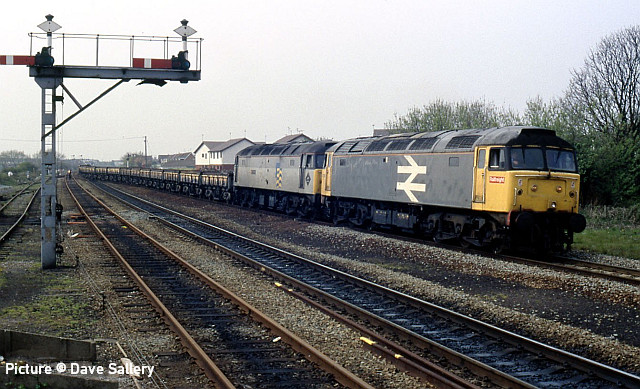
47 019 and 47 125 on an engineer's train leave Prestatyn over the now long-vanished crossover on 22 April 1990.
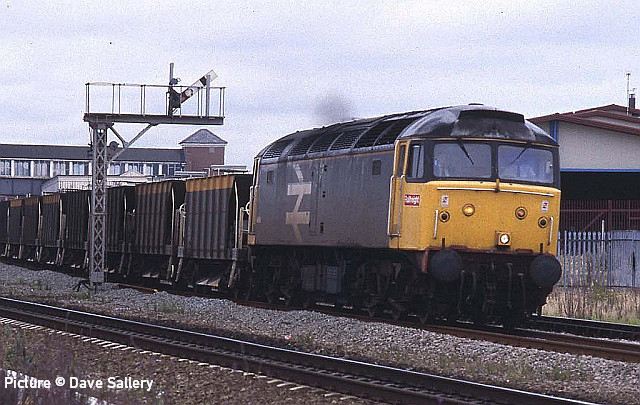
47 356 passes Rhyl on ballast empties for Penmaenmawr, 19 July 1991.
Looking back: Diesels 2006 Part 4 - by David Pool
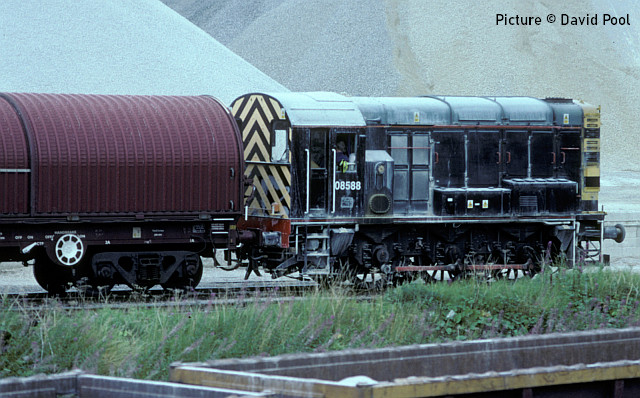
A visit to Peak Forest on 17 August 2006 found some interesting locomotives in the Peakstone sidings. The resident shunter was 08 588, still in the L&NWR black livery, but with a generous weathering of limestone dust. This locomotive is now in the RMS Locotec fleet, and in 2021 was to be seen in Great Yarmouth, shunting the locomotive hauled stock.
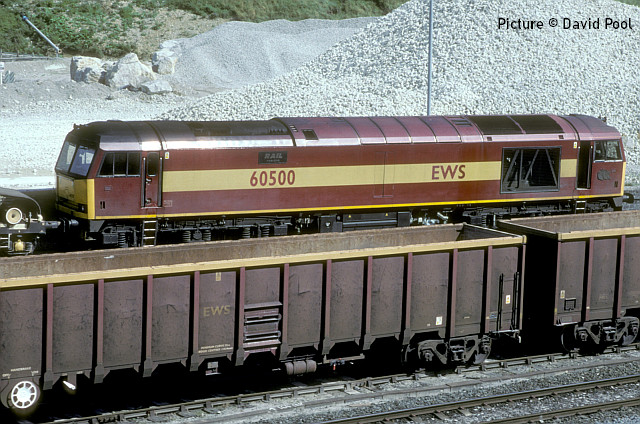
In order to commemorate the 500th issue of Rail magazine, 60 016 Langdale Pikes was renumbered in 2004, becoming 60 500 Rail 500. Photographs of 60 500 seem to be scarce, and it has spent many years at Toton in storage, so I was lucky to see it at Peak Forest on 17 August. It wasn’t the best of photographs, as it did not move from behind the wagons during my visit, but this was the only time I ever saw it.
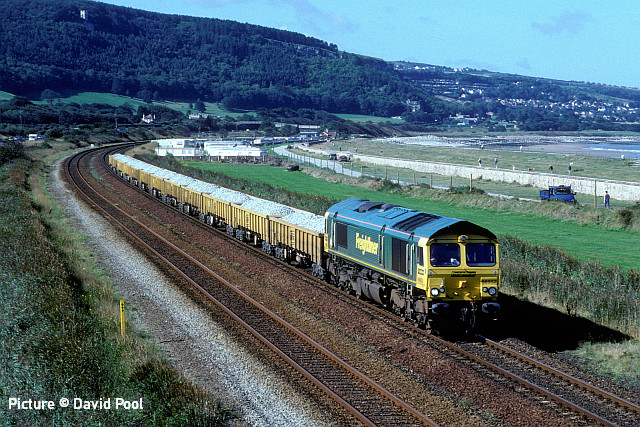
Photography at Pensarn usually produces good results, and if there is any sunshine in North Wales it will probably be sunny at Pensarn! 66 952, one of the two original Low Emission Class 66/9 locomotives was coming from Penmaenmawr on 15 September 2006 and probably going to Crewe with the rake of JNA “Falcon” wagons.
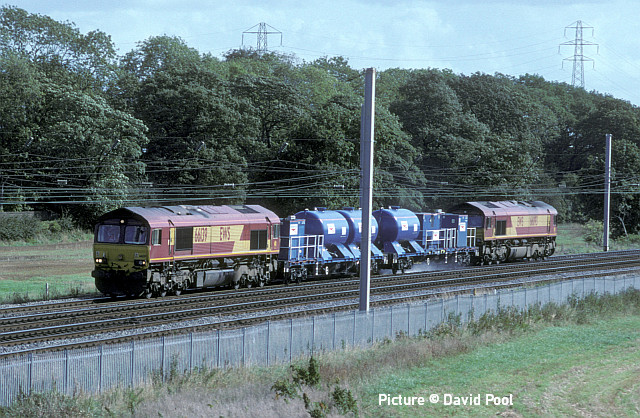
In 2006 the Rail Head Treatment Trains tended to be known as 'Water Cannons', and at first a variety of motive power was used. At Winwick on 19 September 2006 EWS 66 139 and 66 093 were top and tailing the tanks, and the relative cleanliness of the train suggests it was only recently in service. It was heading north on the bidirectional slow line from Warrington RMT, and possibly returning to Springs Branch, where it would have been based.
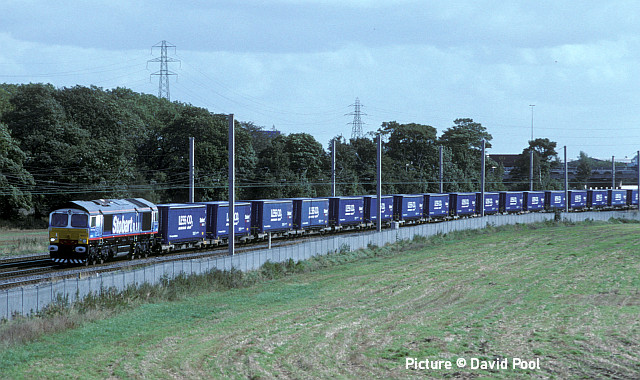
A short time later, the 4S44 11:14 Daventry to Coatbridge appeared behind 66 411 Eddie the Engine, This locomotive was sold to Freightliner in 2011, and eventually moved to Freightliner Poland, where it can be found today.
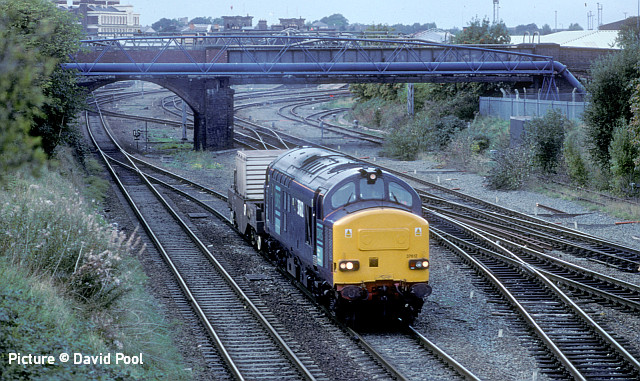
37 612 was one of the Class 37/6 locomotives eventually acquired by DRS after European Passenger Services abandoned plans to use them on overnight international trains in the UK. At first DRS gave them very little use, but in 2005 37 612 was allocated to Nuclear traffic, other Class 37 variants owned by DRS being used on duties other than Nuclear.
On 3 October 2006 37 612 was leaving Chester with a single Nuclear Flask wagon, presumably from Wylfa, heading for Crewe and then Sellafield. The unusual feature of this image is that there is only a single locomotive. One explanation might be that the Flask wagon is empty (with no spent fuel under the Flask cover), so the wagon may have been used simply to test the loading arrangements or for driver training. The normal practice for DRS is to have two locomotives whenever spent fuel is being conveyed, although a single locomotive was used in BR days.
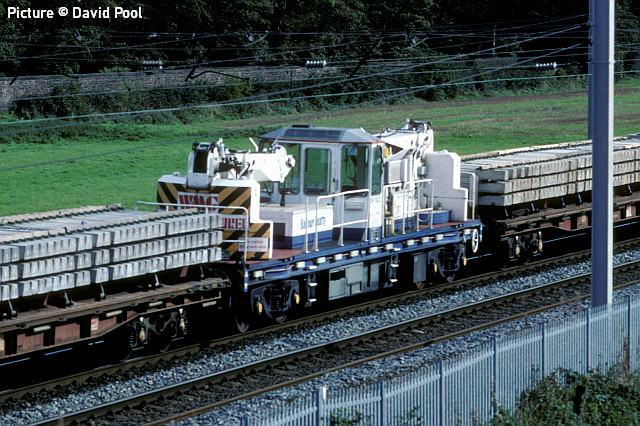
The track machine photographed in a train of track panels at Winwick on 12 October 2006 is a Twin Jib Track Relayer DRP 78222. This self-propelled unit is intended for use on double track lines. It would be on the adjacent track, then remove and replace the track panels on the other track as required, using the two jibs for each panel. If the track to be replaced were to be on a single line, a different machine (a Single Line Track Relayer) would have to be used.
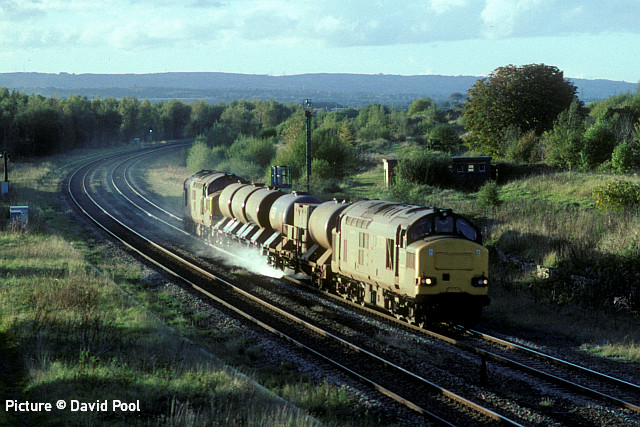
Two of the DRS 37s not allocated for Nuclear duties were being used on the North Wales Coast Water Cannon on 24 October 2006 at Mold Junction. 37 259 and 37 218 might appear to be in Network Rail yellow, but the low sun, together with the combination of track dirt and the effects of the spraying, has produced a golden effect. Underneath the grime there certainly were blue locomotives and tanks, although the loco numbers were only just visible!
Steam returns to Llangollen (press release)
Llangollen Railway is delighted to announce that steam trains ran again at Llangollen again over the August Bank Holiday weekend, thanks to the help of another railway and an historic engine built during the Second World War.
The War Department (WD) "Austerity" saddle tank locomotive No 68067 arrived on Thursday 24 August from the Great Central Railway in
Leicestershire. The engine was built in 1943 by Hudswell-Clarke in Leeds and
will be staying with us whilst repairs are undertaken on our resident steam
locos.
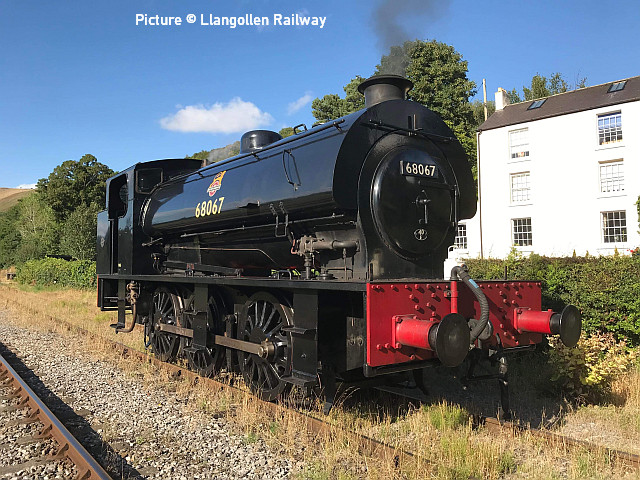
Running with the British Railways number of 68067, the identity of a scrapped classmate, the loco carries shining black British Railways livery and has an interesting history. After being sold on by the War Department, 68067 spent 30 years with the National Coal Board at several collieries, ending up at Bold near St Helens for the final 4 years of its career and picking up the name "Robert".
Lasting in industrial service until 1982, 68067 was amongst the UK's last steam locomotives in use outside of preservation. Whilst at Bold, 68067 also took part in the legendary "Rocket 150" celebrations in 1980, which included a trip onto the mainline to Rainhill, site of the historic 1829 trials that saw Stephenson's Rocket prove that steam locomotives were the best way to operate services on the Liverpool and Manchester Railway, the World's first intercity railway.
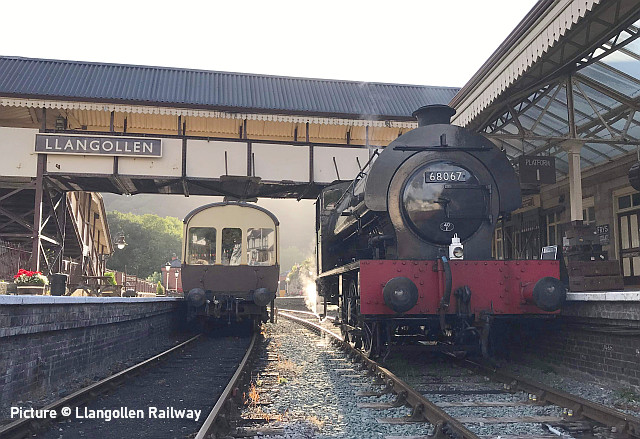
LR Press Officer Terry Pickthall says "We are very pleased to see 68067 arrive with us after a challenging season. Repairs to our resident locomotives have encountered problems and taken longer than expected, leaving us without a steam loco at the height of our season. Although our diesel railcars and locomotives have done a superb job of filling the void, steam traction is very much at the heart of what we do and is always very popular with our visitors. We are very grateful to the loco's owners and wider team at the Great Central Railway who have make 68067's visit to us possible. Everyone has pulled out the stops to get the engine to us in time for the Bank Holiday weekend, which is always a busy one for us".
The loco is staying in North Wales for at least the next few weeks until repairs are complete on the lines' resident GWR "heavy freight" locomotive No 3802.
Bala Gala - report by Jim ikin
Blue skies and sunshine heralded a superb first day for the BLR gala on Saturday 27 August with two visiting locos, Minas de Aller no 2 and Liassic, from Statfold Barn. Also running, albeit not in steam, was BLR’s Triassic tailing to Bala and double heading on the return with Liassic.
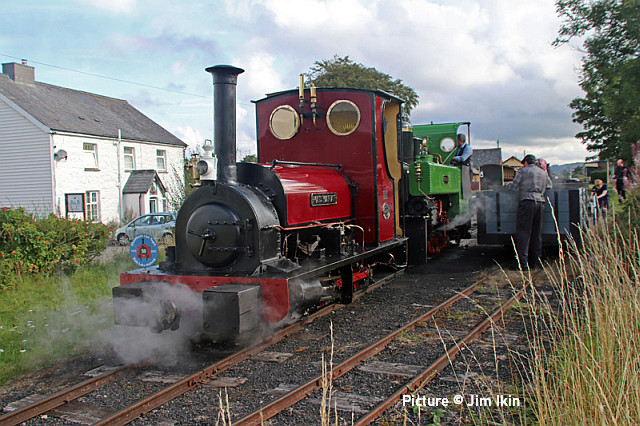
Maid Marian and Minas de Aller no 2 of 1884 at Llanuwchllyn.
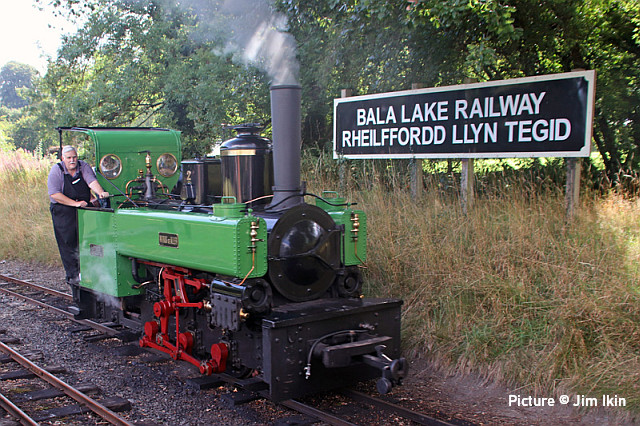
Minas de Aller no 2 at Bala.
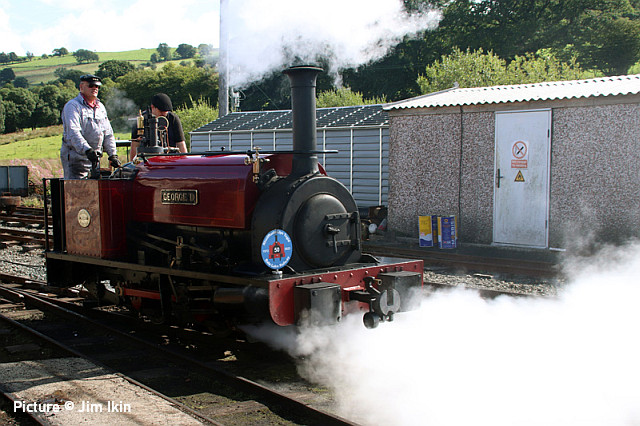
George B at Llanuwchllyn.
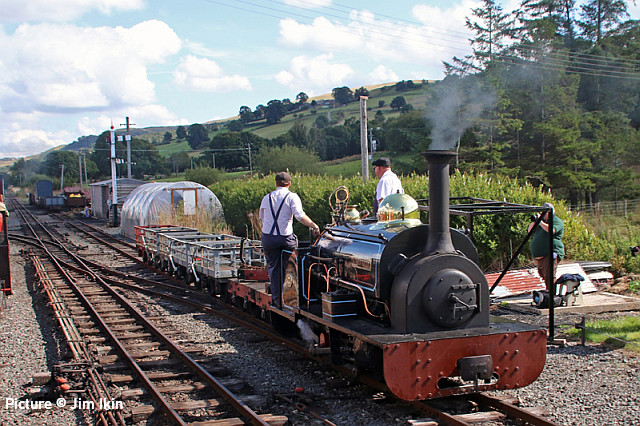
Winifred at Llanuwchllyn.
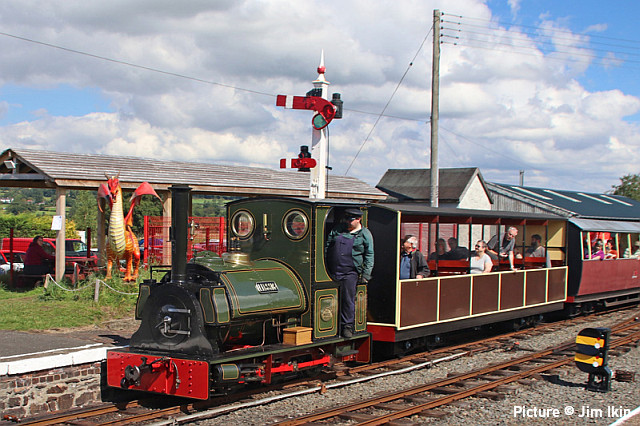
Peckett Liassic of 1911 at Llanuwchllyn.
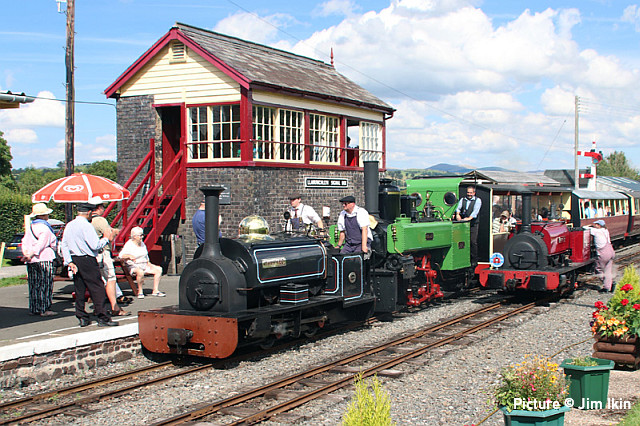
Winifred, Minas de Aller no 2 and Maid Marian at Llanuwchllyn.
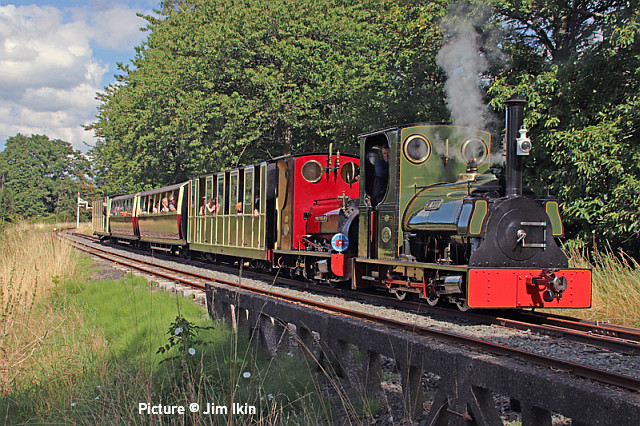
Maid Marian and Liassic at Llangower.
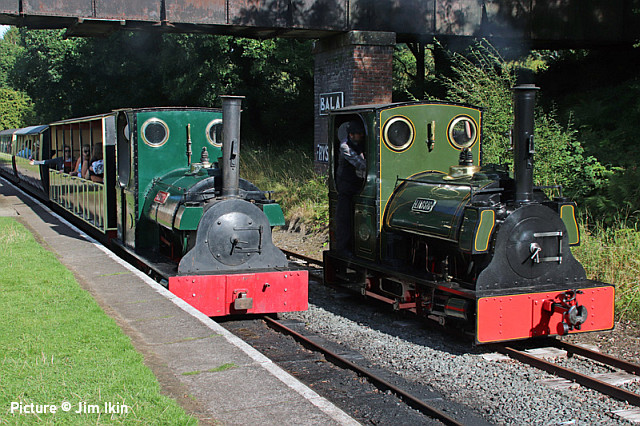
Liassic and Triassic at Bala.
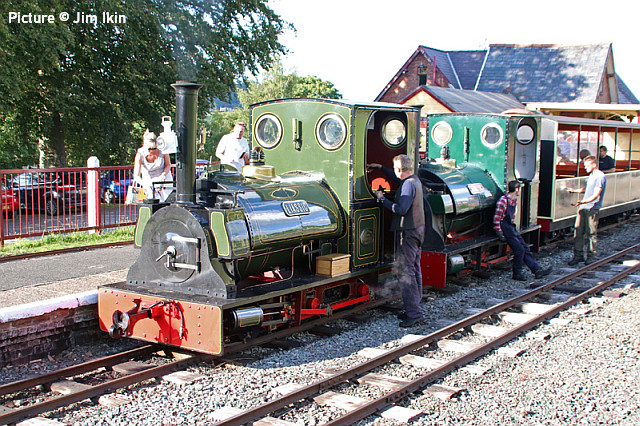
Liassic and Triassic at Llanuwchllyn.
North Wales Coast home page | Archive | Previous Notice Board